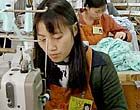 China enjoys about 20 per cent of the $500 billion world garment trade. Its readymade garments exports for the year 2003 was $ 41.28 million. In November 1999, when America signed an agreement with China as part of China's accession to the World trade Organisation, some "safeguards" were built into the agreement, as the American government was under tremendous pressure from its own manufacturers. China enjoys about 20 per cent of the $500 billion world garment trade. Its readymade garments exports for the year 2003 was $ 41.28 million. In November 1999, when America signed an agreement with China as part of China's accession to the World trade Organisation, some "safeguards" were built into the agreement, as the American government was under tremendous pressure from its own manufacturers. In the negotiations, China agreed to a delay in the abolition of quotas and an amendment to the Agreement on Textiles and Clothing (ATC) was made to include safeguards, which allows the US and the EU to delay implementation of the ATC (in the case of China only) until 2008, with a further option to stretch it for the next four years till 2012. This provides an enormous opportunity to Indian exporters, as it does to other rival exporting countries, to gear up as global suppliers. As things stand, China is more than geared to face the opportunity. Its factories are modern, with state-of-the-art machines. Even a medium-sized Chinese factory boasts of 2,000 machines, and the large ones have 10,000 machines under one roof. The latest ones boast capacities of 60 million pieces a year. In the 1980s, China's quotas were generously decided as part of former US President Ronald Reagan's policy of economically engaging China as an Asian counterweight to the then Soviet Union (Taking advantage of the phased abolition of the quotas in 2002, China spread its imprint on the global garment market flooding it with Chinese garments and textiles. China, along with several other Asian garment exporting countries, enjoys low wage rates and an abundant labour supply. But these are not what make it a dominant player. In China, the government retains ownership of 25 per cent of its apparel-manufacturing sector (and 52 per cent of its textile manufacturing units). The Chinese government subsidises its garments and textile industry through an export tax rebate. Besides, the enforcement of its VAT is selective - for exported items, rebate is granted even if the VAT has not been paid for. Currency management through a tightly controlled currency exchange rate is another advantage that has helped the country's dominance in its textiles exports. In the last decade, China has seen rapid economic growth, enormous trade surpluses and huge foreign investments inflows. Yet government controls have kept its currency pegged at 8.2 yuan to the dollar since 1994. China also scores in terms of productivity. Workers in Chinese factories work 'voluntarily' in two shifts of 12 hours each, 313 days a year and achieve productivity levels of 30 garments pieces per person per day. In India, by contrast, the factories run two shifts of eight hours each, 286 days a year and manage only half the productivity of their Chinese counterparts. Infrastructure that meets world standards and port movement is another area where China scores over its rivals in minimising lead-times. For China, geographical proximity to the US and Japanese markets also means faster deliveries and easy supervision of operations by buyers.
also see : The
need for labour reforms
What
is the Multi Fibre Agreement?
Sorry
infrastructure
Indian
garments in a brave new world
The
labour conundrum
|